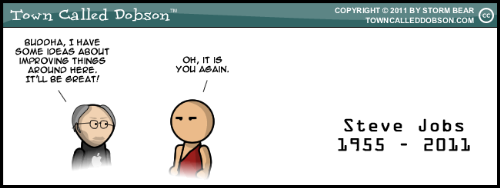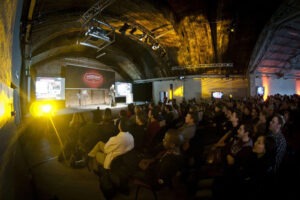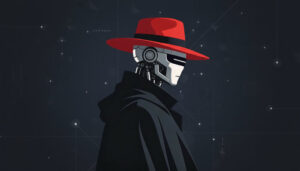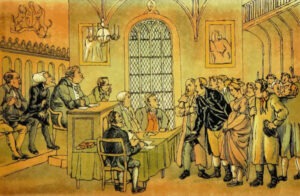A couple of years ago I literally ran into “Woz,” Steve Wozniak, the inventor of the Apple II and co-founder of Apple Computer, while wandering in one of the geeky electronic parts shops in the bowels of Silicon Valley. When I realized whom I had almost accidentally knocked over, I squealed like a child, even though I was 46 years old at the time and well out of diapers. I can only imagine the self-humiliation I would have experienced if I had accidentally bumped into Steve Jobs at the farmer’s market in Palo Alto. I probably would have needed diapers.
Winding the clock back a bit, during the 70s I lived in the ass end of the West Virginia coal fields. I was blessed with Mom’s big brain gene and the opportunities available to those with overwhelming senses of curiosity were few to none at my school. I did meet Carl Sagan in West Virginia, but that was before Carl Sagan was Carl Sagan – well before Cosmos aired. I had multiple aquariums in my room, where I performed rudimentary genetic observation experiments on rainbow trout minnows. When that didn’t satisfy my intellectual curiosity, I got into amateur radio.
In the late 70s, my family moved to North Carolina to find better educational opportunities for me. They found a great high school with a community college right next door. While in high school, my walk home took me through the college. One day I took a short cut though the student center and saw the floor filled with big white boxes blazoned with rainbow colored apples. I asked one of the professors what they were setting up and someone said “microcomputers” and that the college would soon be offering their first classes in computer programming.
My head exploded. I didn’t squeal like a child, but I sure as hell wanted to. One needs to remember, in 1980 a “personal computer” was something exotic, alien – something only Mister Spock could understand. People were just getting into theaters to watch The Empire Strikes Back for the first time ever. The movie WarGames was still three years away. Being able to touch, feel, program and use a personal computer was one of the more foreign and empowering ideas of the time, but only empowering to those who “got it.”
Within a few days I became one of those annoying people you may have met in life, the people who started college before they got out of high school. I had 12 college credit hours by the time I got out of 12th grade – all of it computer science.
The thing that affected me most about that time was that the personal computer, specifically an Apple II, was the first thing, the first object, that didn’t bore me out. I was no longer trying to come up with things to pass the time. I wasn’t building another crystal radio, I wasn’t cataloging minnow populations in the wild streams of West Virginia; I was writing code, learning BASIC, Fortran, COBOL and Pascal. I was totally engaged and my mind was fully liberated by a little beige box from some far-off wonderland called Cupertino.
I was liberated, free to think, to create things from nothing, to expand my mind, to find the actual limits of my own intellect, and only this hippie-inspired box of chips could do these things for me. It changed me to my core and I knew, within my lifetime, it would also change the world.
Others in my hometown also saw the promise of this fundamental change in technology. Just like the current political climate, the personal computing climate in Dobson, NC at that time was divided. It was not Apple vs. Microsoft, or IBM, as it would be now. No, back then the battle lines were clearly drawn between the Apple geeks and those poor misguided individuals who worshiped at the altar of the Atari 800, which actually had its own community in Surry County in those days.
They even had a BBS (bulletin board system) and OMG how they crowed and gleefully bashed other systems on their precious little board. They proclaimed their almightiness and dominance right up to the day when the BBS was seized by the FBI and the SYSOP was imprisoned for wire fraud. It seems he was making a mint selling AT&T phone card numbers via a back door on the BBS.
In the aftermath of the Atari BBS seizure, the ribbing that the local Apple fanboys handed out, with me leading the ring of ProDOS priests, was everything but good-natured.
::cackle::
Even with my distaste of the Atari 800 computer, I did buy an IBM XT a couple of years after I got my Apple IIe, so I was somewhat agnostic. A command line was a command line.
After Christmas in 1983, I got an engraved invitation from the local Apple dealer to see this new computer that was going to change the world. It was an invitation to see the new Apple product, the Macintosh, at a midnight viewing. I hadn’t read much about it, and had never seen a LISA.
The week previous to the “emergence,” I had spent about 30 hours writing a subroutine for someone that would draw a logo on a dot matrix printer and then fill that logo with a waffle-like pattern. It was mind-numbing to get all the pixels right.
When the night of the emergence came, we made a late night out of it – drove to Winston Salem, had a late dinner, saw a late movie and headed to Computer Tree to see the new gizmo at midnight.
We arrived right in the middle of a demonstration of MacPaint and watched as the Apple geek drew a perfect circle on the tiny black and white screen with this odd device called a mouse. The thing that floored me was that the circle was filled with the same waffle pattern I had spent a week coding out. He drew a circle with a waffle pattern in less than a half a second. He could fill it with a crosshatch, change it to black or checkered!
I bought one right then. I traded-in that outmoded XT that was less than a year old for that amazing little machine with 128k of RAM.
That was when I became a fanboy. The same company that liberated me from a boring adolescence had lit my brain on fire with the design potential of the Macintosh. And “yes, I will need the modem.”
Now, on the night of Steve Job’s death, I look back and contemplate his legacy. I have owned 14 Apple computers, a mix of desktops and laptops, all but one a Mac. I have also owned a Newton, two iPods and three iPhones. But, at least for me, these things alone are not his legacy.
Steve Jobs’ legacy in my life can be summed up by how much time my Apple products have saved me and all the things I have built with my Macs. I didn’t need to spend hours removing malware or managing my computer. I plowed all that time into creating things. My mind was liberated from the tasks of running the computer and so I could intensely focus on whatever I was creating at the moment. Picasso had an intern to wash his brushes. Steve Jobs built machines that managed my creative life. He was my paint boy.
His tools have allowed me to do things that I could not imagine when I was catching minnows in the creeks and rivers of West Virginia forty years ago. He is and will be sorely missed.
Storm Williams, an unabashed Apple fanboy, is CEO of the open source office application suite SharkCloud and of Nimbus World Group. He is also the founder of the charitable organization Books for Soldiers and creates the comic strip Town Called Dobson.







